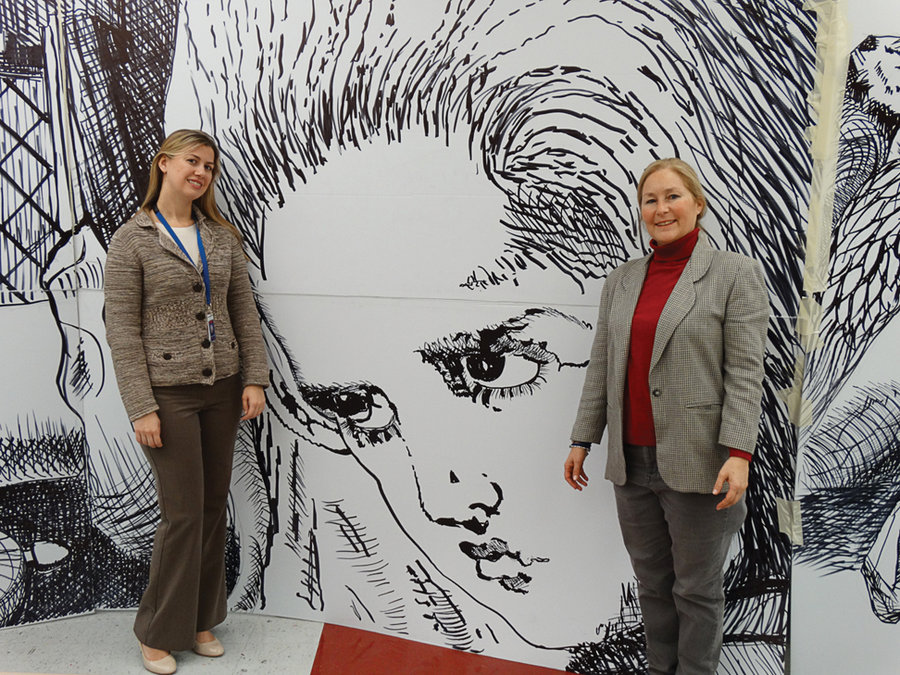When the seventh-grade students at Secaucus Middle School walk through the door of their language arts class, they know they’re in for more than just a conventional reading lesson. As they take their seats in a makeshift “amphitheater,” they are, in a very real sense, stepping into the pages of Lewis Carroll’s classic children’s story, “Alice in Wonderland.”
That’s because the classroom has been completely transformed by a curved, eight-foot-high, 50-foot long mural drawn by art teacher Doug DePice depicting scenes from the book. Culled from the original 1860s drawings by illustrator John Tenniel, the mural firmly establishes the historic roots of the novel.
Yet at the same time, the students embrace the modern era by reading the work on the media of their choosing, meaning for most an e-reader of some sort.
“It’s better with the electronics because if you bring your own you can make notes and highlight certain words and vocabulary,” said Luigi De Cecco, 12, last week.
Classmate Ashley White, 12, disagreed. “I didn’t bring in a device. I brought in a book. I like books. I like the way they smell.” As for taking notes, that’s no problem. “I underline and highlight,” she said.
Alice in Kindle-land
Meghan Maddalena has been teaching language arts for five years, three of them at the Secaucus Middle School. Pamela Stokols has been teaching the same subject for 31 years. “Longer than she’s alive,” she joked.
The two joined their classes together for the Alice lessons, which will last about a month. “We started with a whole week of Victorian era history,” said Maddalena. “We talked about Lewis Carroll, we talked about Victorian England and what the people wore and what they did and what their jobs were and how long they lived and what the sanitary conditions were like… or what the unsanitary conditions were like.”
“It’s about a young girl growing up. Just like the middle schoolers: they have one foot in elementary and the other foot in high school. They’re in the middle.” – Pamela Stokols
____________
Lessons include reading aloud and classroom assignments, both individually and in collaboration with others.
“It’s cool to have the classes merged because you get to interact with other people,” said Luigi.
“I like that we answer questions and we sort of get into the story, analyzing it instead of just reading it,” added Ashley. “Like when we go into how the caucus race relates to politics.”
“We were talking about the caucus race in the novel and at the end they have no way to determine who won the race, so they decide they all won and they all should get prizes,” said Maddalena. As a result Alice is presented with her own thimble back as a prize. “So we said to the kids, ‘What is that like if you have something and somebody takes it from you and then gives it back to you?’ And they said it’s like a tax rebate. We were really shocked that a seventh grader would even know what a tax rebate was. But it was kind of a confirmation to us that they’re taking it and not just thinking of it as a children’s story but they’re relating it to larger concepts. Which is what they’ll need to do when they’re reading college literature.”
Down the rabbit hole
“Alice in Wonderland” is, both teachers feel, a perfect book for this age group.
“It’s about a young girl growing up,” said Stokols. “Just like the middle schoolers: they have one foot in elementary and the other foot in high school. They’re in the middle.”
Maddalena agreed. “Alice is at that age where she’s got to decide, ‘Am I a little kid? Am I grown up? Am I too big for some things, too small for other things?’”
The project was spawned when DePice spotted a poster of the original Tenniel illustrations on the wall of Maddalena’s office. Having done a project last year utilizing artwork to enhance a lesson on Anne Frank, he immediately began thinking of ways to craft more comprehensive lessons around Alice.
“We keep saying he went down the rabbit hole,” said Maddalena. “He did one [panel] and then like two days later I go back to his room and there’s another one. And then before you know it – fifty feet of Alice. Eight magnum Sharpie markers later.”
With too much mural for one classroom, it was pure luck that Stokols was teaching the same grade class in the same subject on the other side of – guess what? – a folding wall. So down came the wall and the classes merged. “It was serendipity, how it all came together,” said Maddalena.
The version of the book on the electronic devices includes the original Tenniel illustrations, so the students can compare them with DePice’s interpretations. “There are a lot of things that aren’t actually in the book,” said Ashley about the mural. “Like over there you see by the little door, there’s a girl. You have the same girl right there, behind the mushroom.”
“And there’s a little poster that says ‘I love books,’” pointed out Luigi. Another corner of the mural depicts an easel on which is drawn an easel on which is drawn an easel…
“I’ve taught from seventh grade to twelfth grade, so sometimes I’ll breeze right over a word,” said Maddalena. “And Pam will say, ‘Does anybody know what that means?’ So along with the kids getting the benefit of two teachers, we also get the benefit of having the other person’s point of view.”
“We’re working together and the students are working together,” said Stokols.
Although this is the first collaboration between the two classes, “We don’t know if we’re ever going to stop,” said Maddalena. “We like it.”
Art Schwartz may be reached at arts@hudsonreporter.com.
